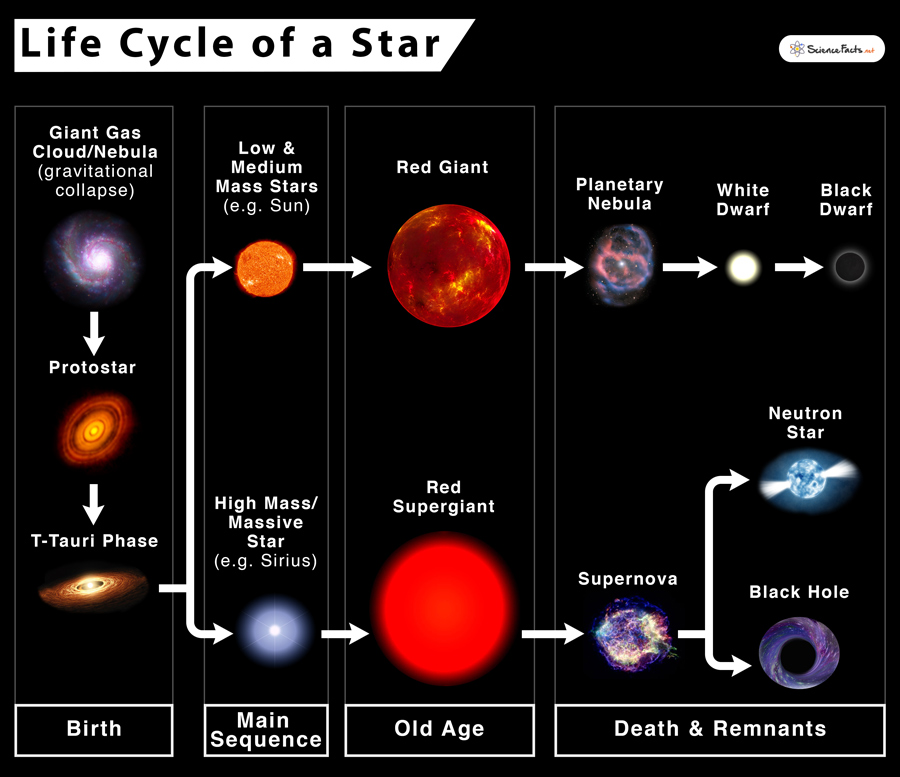Life Cycle of a Star
What is a Star? A star is a giant sphere of extremely hot, luminous gas (mostly hydrogen and helium) held together by gravity. A few examples of well-known stars are Pollux, Sirius, Vega, Polaris, and our own Sun. Stars are essentially the building blocks of galaxies and are the source of all the heavier elements. Their age, composition, and distribution are essential for studying the Universe. Therefore, we must study stellar evolution in detail. Stellar evolution is the process by which a star changes through time. It can be compared to a human life cycle.
All stars go through roughly the same life cycle. However, their life spans vary greatly, as well as how they eventually die.
What Determines the Life Cycle of a Star
The mass determines a star’s life cycle. The star’s mass depends upon the amount of stellar material available in the nebula from which it forms. The more massive a star, the shorter is its life span. The reason is that the hydrogen supply of a massive star is used up much quicker due to the higher core temperatures of such stars. Other types of stars tend to burn for longer, though they also tend to be much colder.
Stars Based on Their Mass
1. Low Mass Stars
Low mass stars have a mass not more than 0.5 solar masses. These stars are the smallest, coldest and dimmest stars in the Universe. They burn red, orange, or in some cases yellow due to their low heat. They burn up their fuel very slowly and have incredibly long lives, anywhere from 10 to 50 billion years. An excellent example of a low mass star is the red dwarf Proxima Centauri, which is closest to the Sun.
2. Medium Mass Stars
Medium mass stars have a mass anywhere from 0.5 to around 3 solar masses. They burn orange and yellow and have an average lifespan of around 5-15 billion years. Our Sun is a medium mass star, and its lifespan is roughly around 11-12 billion years.
3. High Mass Stars
High mass stars have a mass greater than 3 solar masses. They are extremely hot and glow blue and white. They have very short life spans, from a couple of billion years to as low as 10 million years only, and they end their lives with a spectacular explosion. Sirius, the brightest star in the night sky, is a blue high mass star.
Different Stages of a Star’s Life Cycle
The life cycle of a star can be divided into very distinct stages. As stated previously, we can compare it to a human life cycle for easier understanding, as it spans from birth to middle age, and finally, the death of a star.
The first four stages are common to all types of stars.
1. Giant Gas Cloud/Nebula
At the first stage of their lives, stars are formed by the gravitational collapse of giant clouds of dust and gas called Nebulae. This stage is the start of their life cycle.
2. Protostar
A protostar is the result of the gravitational collapse of a nebula. It is the formative phase of a star. During this phase, the infant star strives to gain equilibrium between its internal forces and gravity. A Protostar starts very vastly. It can be billions of kilometers in diameter. It usually lasts for 100,000 years. During this period, the protostar spins very rapidly, generating intense heat and pressure and causing the gas cloud to collapse further.
When the temperature reaches about 10 million K, hydrogen fusion can finally occur, and the star is born.
3. T-Tauri Phase
Before fusion begins, the protostar goes through a period called the T-Tauri phase. At this stage, the core temperatures are still too low for hydrogen fusion, so all the star energy comes from the gravitational force only. The star at this point is about the same size as a low or medium mass star. However, it is much brighter. This period can last up to 100 million years and represents a period of fluctuations in the brightness of a star as it tries to balance its internal and gravitational forces. Once nuclear fusion starts and equilibrium is achieved, the star is considered a Main Sequence star.
4. Main Sequence (Small to Average Stars/Massive Stars)
The Main Sequence signifies the portion of a star’s life where its core is capable of hydrogen fusion. 90% of a star’s life is spent in this stage. The stars in the Main Sequence are of many different masses, colors, and brightness. The amount of time a star spends on the Main Sequence depends directly upon its mass. average stars like the Sun stay on the Main Sequence for billions of years. The smallest stars, the red dwarfs, burn their hydrogen supplies so slowly that none of them have left the Main Sequence since the Universe was formed!
On the other hand, the most massive stars, like Sirius, will use up their hydrogen quickly and exit the Main Sequence after only a few million years. When a star has fused all the hydrogen in its core to helium, it exits the Main Sequence and enters its death throes.
How a star dies depends on its mass.
The following three stages apply only to low and medium(average) mass stars.
5. Red Giant
When a star has fused all the hydrogen in its core, its nuclear radiation output ceases. As a result, the star once again starts collapsing due to gravity. The energy generated by this collapse heats the core enough that the hydrogen in the surrounding stellar atmosphere can be burnt. This process causes the star’s outer layers to expand and cool down to just around 2500-3500 K, thus becoming redder. This stage in a star’s life can last for up to a billion years, and the stars can swell up to 100-1000 times the size of the Sun.
Planetary Nebula: The star’s core continues to heat up, reaching temperatures of up to 100 million K, and helium fusion can now take place in the core. For small and average stars like the Sun, the core will never get hot enough for further fusion. Instead, once the helium in the core is used up, the star expels the outer layers of gas in an explosion, called a planetary nebula, leaving behind a white dwarf.
6. White Dwarf
Once the star’s outer layers are shed, only a tiny core comprising primarily carbon and oxygen remains. The star is called a White Dwarf. Here, the mass of an entire stellar core is condensed into a body roughly the size of the Earth. Such a small size is possible due to the pressure exerted by the fast-moving electrons. This fate is only for those stars whose cores are not bigger than 1.4 solar masses. These stars are scorching; hence, they glow white.
7. Black Dwarf
Black dwarfs are the final stage in the life of a low to medium mass star. They are the remnants of white dwarfs, formed due to the gradual cooling and dimming as they burn their remaining fuel. Eventually, they will exhaust their fuel and keep dimming until they are no longer visible to us. This process takes such a long time that no black dwarfs have formed since the beginning of the Universe, so they are strictly theoretical.
The following three stages apply only to high (massive) mass stars.
5. Red Supergiant
For stars with a mass 8-9 times that of the Sun, the core temperatures become so high that nuclear fusion can occur even after the helium is exhausted. They can swell up to truly spectacular sizes; for example, Betelgeuse, a red supergiant and the tenth brightest star in the sky, is so massive that if it were in the Sun’s place, it would stretch till Jupiter! The process of nuclear fusion in the core carries on till iron is formed. No further fusion can occur at this stage, as fusing iron consumes energy rather than release it.
6. Supernova
The moment the core of a supergiant star turns to iron, it has reached the end of its life. The star collapses instantly under the enormous gravity exerted on its heavy iron core. The core shrinks from around 5000 miles across to just a couple dozen in a matter of seconds, and the temperatures can reach 100 billion K. This collapse triggers an incredible explosion, known as a Supernova. Supernovae are some of the brightest and most violent events in the Universe; they can outshine entire galaxies! The energy released during a supernova is so great that a fusion of iron can finally occur, and all heavier elements are created in the explosion.
7. Neutron Star or Black Hole
After a supernova explosion, all that remains of the star is its core. What happens to this core depends on its mass.
a) Neutron Star: If the collapsing core is of 1.4-3 solar masses, it forms a Neutron Star. A neutron star is a highly dense, heavy, and trim body comprised of neutrally charged neutrons. The force of gravity on the collapsing core is so enormous that the negatively charged electrons are pushed right into the nucleus, where they combine with the positively charged protons to form neutrons. As such, a vast mass is compressed into a body no more than 20 km in diameter. Neutron stars are the densest and heaviest objects in the Universe.
b) Black Hole: For stellar cores of more than 3 solar masses, the force of gravity is so strong that the collapse is unstoppable. Such a big mass collapses to a point known as a singularity. Here, the gravitational force is so strong that nothing can escape it, not even light. Such a phenomenon is called a Black Hole. Their gravity is so strong that black holes even pull in neighboring stars and planets and “eat” them! Since no light or other electromagnetic emissions can escape a black hole, our only way to detect them is to observe them “feeding” on the stellar matter.
FAQs
Ans: All stars follow a 7-step life cycle from their birth in a nebula to ending up as stellar remnants. It goes from a Protostar to the T-Tauri phase, then the Main Sequence, Red giant or supergiant, fusion of the heavier elements, and finally a Planetary Nebula or a Supernova.
Ans: Brown dwarfs are essentially failed stars. Due to their small size, the core of these stars never achieves a temperature high enough for hydrogen fusion. They can be anywhere from 15 to 80 times the size of Jupiter and are often confused with planets due to their low luminosity.
Ans: Neutron stars do not last forever. Like white dwarfs, they radiate their energy out very slowly and eventually fade until they become undetectable.
Ans. Neutron stars continue to rotate just like the original star. However, since they are much smaller and denser, they rotate at incredible speeds – up to hundreds of times in a second. The rotation, together with their strong magnetic field, causes electromagnetic radiation emitted from the poles. This radiation is detected in pulses; hence, these stars were named “Pulsars”.
-
References
Article was last reviewed on Thursday, February 2, 2023








